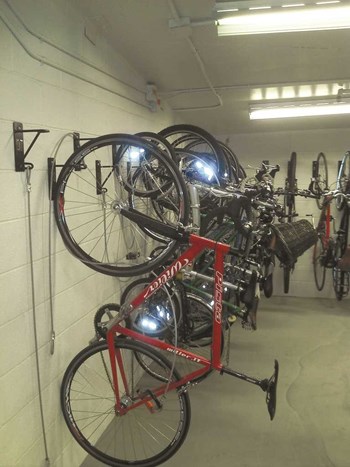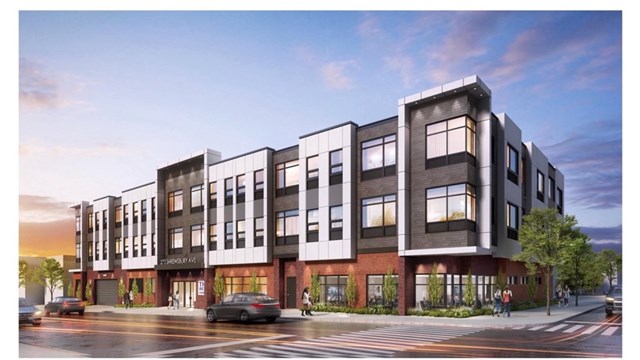
With the price of gasoline rising, daily traffic snarls, a desire to live a healthier life and the responsibility to lessen the effect of one's carbon footprint, there are many reasons to own a bike.
Buying the bike is just the beginning. Bicycles today are not cheap—some can cost more than the price of a used car, which brings to mind the security of our valuable two-wheelers. In a residential development other issues arise such as the wear-and-tear on the building. Even if a small percentage of residents in a complex have a bicycle...those bikes’ comings-and-goings will bear their mark on the floors, the interior of the elevators and the hallway walls.
Where to Put Them?
On the surface, owning a bicycle may not seem like a complex subject, but when issues are examined the long term effects of residential bicycle ownership is reviewed, it can turn into a major headache, and a big bone of contention for managers.
Consider, for instance, recent comments to a bicyclist’s blog query about storage; responses range from the practical to the whimsical:
“Hang the front tire over the patio rail.”
“One hundred percent ‘no’ to bike storage areas. You can just kiss your bike goodbye if you store it there.”
“They’re at the foot of my bed … My bikes are the last thing I see when I go to bed and the first thing I see when I wake up.”
“A big selling point for our apartment was the tile floors and cinder block walls. The walls are kinda ugly, but no bike is going to hurt them, and the dirt wipes off easy.”
“Fill the tires with helium and let them float to the roof.”
Bicycling has become big in New Jersey, especially when the winter winds subside and the residents want to escape their winter hibernation and explore.
Bike Enthusiasts
Garden State residents are fortunate to live in one of the best biking states in the US. In fact in 2011, Bicycling Magazine, reported that the League of American Bicyclists ranked New Jersey as the seventh best bicycling state in the nation. According to the magazine, “New Jersey has some great road routes especially in Morris, Somerset, Hunterdon and Sussex Counties. While traffic can be congested and motorists at times can be rude and sometimes a bit dangerous, on the weekends, when traffic is less congested, there are great scenic bike trails. There is also a growing racing contingency in New Jersey. There is also some great mountain biking too in places like Allamuchy and Wawayanda.”
The plans for the future are exciting, but those who own bikes know that there's already a lot to love. Throughout the state there are literally hundreds of miles of bike paths. One website has become an invaluable resource for New Jersey's biking community: njbike map.com. This website breaks down the state's bike paths by county and starting points; provides maps (both statewide and regional); hints/tips for the Jersey biker; weather; and web links for biking enthusiasts.
The website, started by Dustin J. Farnum Jr. in 2002 is updated frequently and according to Farnum, “the information on the maps is the result of more than 30 years experience in the area. I have traveled about 85 percent of the state by bicycle and I take notes to ensure that those using the map have the best experience possible.”
In urban areas such as Hoboken, Jersey City and Hackensack, these cities are committed to providing safe bike routes not only for enthusiasts but also for commuters. Outside of PATH stations in Hoboken and Jersey City commuter bikers will find numerous bike racks for utilization. Additionally at many New Jersey Transit bus stops and train stations, commuter bikers will also find secure locations for parking their bikes.
According to Michael Pacella, a spokesman for New Jersey Transit, “we support and encourage bike access to all our terminals, facilities and services by providing accommodations for our customers. There is no extra charge for bicycles brought aboard NJ Transit vehicles, access is allowed from all station platforms and permits are not required.”
The Need for Storage
At the picturesque Rutherford Tudor Garden development, two different types of bike storage are offered. There is a bike storage room in each of the buildings available to all, which in addition to providing secure bike storage, also provides equipment lockers for storage of bike helmets, and other bike accessories—as well such as benches. This amenity is considered a plus to residents of the development since there is a NJ Transit rail station located less than half-a-mile away which provides secure bike parking. Additionally, the condo is located near the Meadowlands Trail, a park system, which is preserving the Hackensack River Watershed.
“The bike storage at Tudor Garden is amazing. When I first moved in I didn't own a bike, but then I saw all my neighbors having fun so I got one as well. My unit is small but having the storage here makes it so convenient,” says Alicia Comar, a Tudor Garden resident. “I would never move into a development that didn't have bike storage. I've become spoiled, this is something that all condo buyers should look for,” she says. Comar pointed out that space is at a premium in the development, and being able to have a secure storage area is great.
Whether a specially designed storage area such as at Tudor Garden or a fenced off part of a parking garage, bike storage is becoming easier to find especially in new buildings. As of 2009, most new developments, including multifamily residential, are including bike storage as part of the main design. Offering bike storage benefits developers in two ways: first, it is an attractive amenity that a majority of buyers look for; and secondly, it offers developers a relatively inexpensive way to gain points towards LEED certification, which measures a building's environmental impact.
The Mountainview, a luxury condominium development in Woodland Lincoln Park, offered only a small bike storage room just off the parking garage next to the laundry room. According to William Marosits, a board member and a weekend biker, “the bike storage area is one of the few amenities that doesn't create long discussions at board meetings. Everyone here loves having it. Most recently we discussed expanding the size of the area by utilizing an underutilized storage room. The board was unanimous in agreeing to the expansion, but there was some descent regarding the cost, like painting and lighting. At that point many of my neighbors volunteered their time and money to make it happen. My neighbors donated paint and lights, and gave up their weekend to get it done.”
The question that comes to mind is where are all these bikes stored. Some bicycle storage areas are merely a locked storage room where residents merely park their bikes and put a chain around the wheel. However, as the bike storage trend continues there are many companies now providing custom bicycle storage solutions. Two of the biggest names in the industry are WireCrafters and Rudy Rack.
According to Jamie Barnard, owner of Giant Industrial Installations, and a representative for national distributor WireCrafters explains the benefits, “they [the board and management] turn an unused, disorganized and cluttered basement storage room into a moneymaker for the co-op or condo.”
And according to WireCrafters, there are a wide variety of storage solutions. WireCrafters offers a multiple bicycle storage solution, a double-tiered rack that comes in a variety of sizes that allows maximum storage in a minimal area.
Joshua Goldman, president of New Jersey-based Bargold Storage Systems agrees that the bike storage trend is here to stay. Goldman’s company is working with Rudy Rack, a Wisconsin-based distributor, to put in the bike rooms, according to Staci Galloway, Rudy Rack vice president.
“You have a lot of people in high-end buildings, they can pay $10,000 for a bike these days, so they don’t want to put it in a storage facility, leaning it against the wall, or just sticking it somewhere that it could get damaged. It’s an investment. So having proper racks that hold the bike properly and don’t do any damage to it, and don’t risk getting it scratched or trashing the rims by hanging it on a hook, can be key for those types of buildings.”
For buildings where space is an issue, she says, high-density racks might be a solution. “It’s really going to fit a ton of bikes in a small amount of space. Each bike room is really dependent on different goals, and different setups.”
Galloway says usually the bike racks are a one-time purchase, and it’s not a lease or rental arrangement like typical storage would be. Bikes can be individually secured and locked to the rack itself, she says.
While storage rules should be adjusted to a site's physical limitations and allowances, this is a sample guideline for boards—a typical arrangement, set up by the directors at a 460-unit development which boasts two locked bike storage facilities:
Bicycle storage spaces are available to residents only. Resident owners have the right of first refusal regarding bike storage availability.
All bicycles must be registered with the Management Office.
Bicycles are not permitted in the lobby. All bikes must exit through the back door located next to the loading dock.
Bicycles must be locked and stored only in the racks provided.
Neither Management nor the Condominium Association assumes responsibility for the loss, theft or damage to any bicycle.
If the sale of a unit or termination of a residential lease results in an individual moving out of the building, the bicycle space reverts to the association for reassignment.
Failure to comply with the bicycle storage rules or to pay the associated fees shall be sufficient cause for the Board of Directors and Management to revoke bicycle storage privileges.
Bicycle Storage Bottom Line
Providing bike storage has also presented some boards with a new income opportunity. Most developments charge modest fees, usually to pay for the initial investment. Some developments in Hoboken and Jersey City, charge upwards of $100 per month.
In most buildings, however, either the service is free or the fee is nominal, maybe $10 a month. That small sum is mostly intended to discourage the leaving of unused and unusable bikes in storage ad infinitum, rather than to raise revenue.
According to Comar, “there is a monthly fee, and it's not that much. When I first moved in it was about $15 per month, now it costs $17 per month...that's less than the cost of a movie and snacks. Every Saturday and Sunday when I'm out biking I think to myself what a good deal I have.”
“It doesn't cost that much, we only charge those who use the area the basic operating costs,” says Marosits. “If bikes weren't in those two rooms, they would be totally unused and that, in my opinion, is a waste. As I said the board only charges those who use the amenity what it costs us to operate the area, cleaning, basic maintenance and electricity. My neighbors who don't use it pay nothing—it's not a part of the maintenance. So everyone is happy. If we didn't have the storage area we'd have all other sorts of problems, such as the wear and tear the bikes would cause to lobbies and hallways. The storage area saves us money in the long term. As I said, it's a win-win for everyone.”
When it comes to common areas, management has to define what is acceptable—and what is not—when it comes to bicycle storage. It's a challenge that seems to be growing with each passing year, as the interest, and the list that makes bicycling a good idea grows.
J.M. Wilson is a freelance writer and a frequent contributor to The Cooperator. Associate Editor Liam P. Cusack contributed to this article.






Leave a Comment